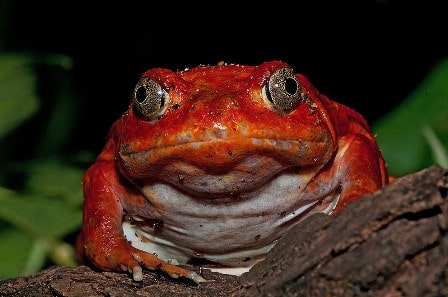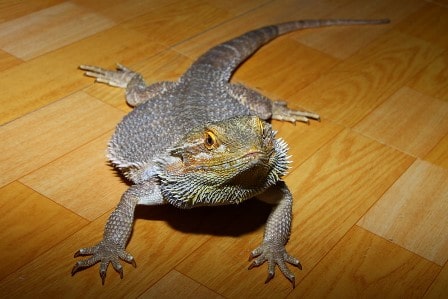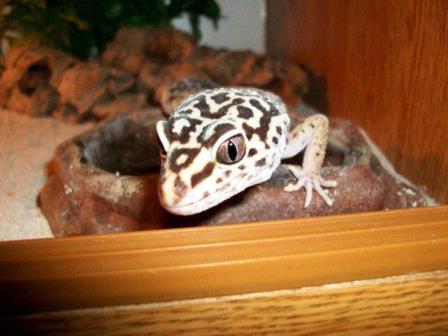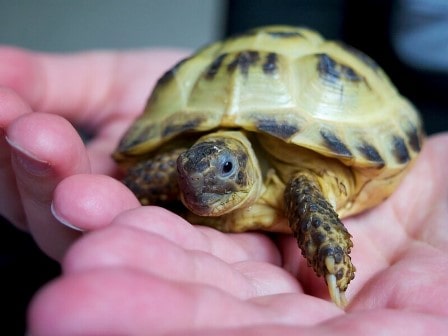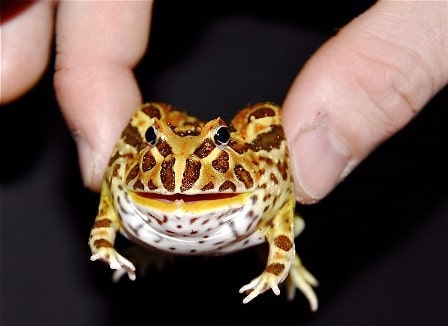Some people are allergic to the fur animals like dogs and cats and don’t like to keep them as pets. Reptiles and amphibians are excellent options for these people. You don’t have to find a separate time from your busy schedule to take care of these pet animals. Low maintenance is required in keeping reptiles and amphibians as pets in your home.
Some of the best beginner reptiles and amphibians to keep as pets are Bearded dragons, Tomato frogs, Leopard geckos, and corn snakes.
But before bringing any reptiles or amphibians to your home, you need to consider their way of living, feeding, the number of years they will live, and many others. Again there is a risk of biting in some reptiles like corn snakes.
A captive corn snake may have a mild temperament compared to a wild one, but you cannot count on it. You need to choose wisely when selecting any reptiles or amphibians as pets.
MORE POSTS: BIRDS THAT START WITH K AND HAVE 10 LETTERS
What Are The 6 Best Beginner Reptiles And Amphibians To Be kept As pets?
#1.Bearded Dragon
Do you love reptiles and want to keep them as pets? If yes, the bearded dragon is a good option. These reptiles grow 24 inches long and have a lifespan of approximately ten years.
Bearded dragons quickly develop a good bond with its owner and family members. You will find beards both in male and female bearded dragons. These reptiles puff their beard to appear larger than their prey.
A young bearded dragon eats insects like cricket, wax worms, and mealworms to satisfy the nutritional requirements of its body. They even eat plants like leafy vegetables, carrots, peas, and squash. You can feed these vegetables daily to bearded dragons.
Fruits are also a good option for bearded dragons. You can feed berries, citrus fruits, and melon to bearded dragons in seven days intervals. Simultaneously you need to sprinkle calcium and vitamin D powder on the food of the Bearded dragon within one month.
When the bearded dragon grows old, it becomes herbivorous and feeds only on plants. If you want a bearded dragon to grow correctly, you must have a terrarium of 151-liter volume.
They are ectothermic animals, meaning the tank’s cool side should be between 75 to 85 degrees Fahrenheit and the tank’s heated side will be between 95 to 100 degrees Fahrenheit. These animals are active during the day time and sleep at night time.
#2.Leopard Gecko
Leopard Gecko is a reptile that requires very little care and maintenance. They grow almost one foot and have a lifespan of nine to ten years. Leopard Geckos are usually yellowish with uneven black spots. These creatures have eyelids but don’t have sticky toes. So this reptile cannot climb on walls.
Leopard Geckos are nocturnal animals and make sounds when they are hungry. Try to socialize this animal right from the beginning by gently holding and patting it. But don’t over-touch Leopard Gecko because it can cause stress.
Leopard Geckos communicate by their tail. If you find Leopard Gecko moving the tip of its tail rapidly, it indicates that it is eager to mate or needs food immediately.
A 75.70-liter tank is sufficient to keep the leopard gecko. Try to keep both male and female leopard geckos if you want them to reproduce. You must soak these creatures in lukewarm water two times a week to hydrate their bodies.
Try to have a white incandescent bulb on the tank so that these creatures can bask during day time. You can have a red or purple color bulb that can provide warmth to these creatures at night.
Remember, Leopard Geckos is a cold-blooded animal that cannot produce internal heat. You have to keep the basking side of the tank at 85 to 88 degrees Fahrenheit and the cooler tank side at 70 to 75 degrees Fahrenheit.
Leopard geckos usually stay with lizards. So, they don’t require much humidity; hence, you can keep the humidity level at 30 to 40 percent.
Leopard Geckos love to eat insects. You have to feed this reptile various species of crickets, wax worms, and mealworms. Try to feed live crickets, mainly gut-loaded (vitamin-rich diet). You must also sprinkle the multivitamin powder on insects before feeding Leopard Geckos.
The best way of doing this procedure is to bring a zip-lock bag and add some multivitamin powder. Then add the insects like live cricket and shake the bag for a few seconds. Then drop the insect directly into the tank. Adult Leopard Geckos need such multivitamin-coated insects every other day.
#3.Corn snake
Do you want to own a snake for the first time in your house? If yes, then corn snake is an excellent option for you. They are easy to care for and require less maintenance. The corn snake usually grows 2.5 to 6 feet long and lives for almost 15 to 20 years. These animals are quiet, and you can easily control them.
You must have a 20-gallon glass tank for keeping corn snakes as pets. Always keep the tank lid tight because corn snakes will try to push the lid by the nose and escape from the tank.
If the snake escapes from the tank, it can be lost or scary for the guests coming to your house. You can keep an incandescent lamp on the tank for the proper temperature inside the tank. The basking side temperature of the tank can be 85 to 88 degrees Fahrenheit.
But the temperature needs to be reduced to 75-degree Fahrenheit at night. For corn snakes, you can keep the humidity level within 35 to 60 percent in the tank. You can use a hygrometer to measure the tank’s humidity on cold winter days. If the humidity becomes lower than 35 percent, then you need to mist the tank often.
They are carnivorous animals. When these animals live in the jungle, they try to catch most of their prey by smell and not vision. But here you are, keeping them in a tank.
So, you can feed them pre-killed frozen mice or pinkie mice. When the corn snake is young, you can feed them small mice, and when it grows larger, you can feed them large mice. You have to feed a baby corn snake every seven days, whereas an adult corn snake needs to be fed within two to three days.
These animals even drink water. So you can keep a clean water dish in the tank.
The appetite of corn snakes decreases at the time of shedding. Whenever you observe cloudy eyes or dullness in their skin color, then it’s an indication that corn snakes will shed and reduce their dietary intake.
#4. Russian Tortoise
Russian tortoises are active and friendly animals and quickly develop a good bond with their owner and other family members. The adult Russian tortoise is 8 to 10 inches long and has lived almost 50 years. These tortoises are reddish brown or black and become light yellow during scutes.
Russian tortoises can be kept indoors or outdoors where the temperature is high.
They are herbivorous animals and feed on leafy green vegetables, weeds, and flowers.
They also drink water. You can keep a water dish of lower depth for this tortoise, and the water needs to empty within three days. Russian tortoises are prone to parasites. If you observe any worms on their poop, it indicates that they have parasites in their body.
These animals enjoy soaking their body in water. But don’t allow Russian tortoise to soak its body consistently in water because it can hamper its shells. If you are keeping them outdoors, they need an environment where they can burrow, aestivate and hibernate if necessary. The warm outside temperature is enough for Russian tortoises to bask in the sun and eat leafy vegetables available outside. But if you wish to keep them indoors, you must have a large tank and maintain a temperature of 90 -95 degrees Fahrenheit during the day. You can keep the night
temperature at 60 degrees Fahrenheit for the Russian tortoise. In short, you have to build a habitat that will have 12 hours day time and 12 hours of nighttime. If the Russian tortoise lives in a too-cold atmosphere, it cannot properly digest its food.
You also need to grow some plants in the tank so that they can feed on them directly and don’t have to depend on market products. Additionally, sprinkle some calcium and vitamin D powder on the food of Russian tortoise so that it can meet its nutritional requirements.
Never give fruits to Russian tortoises as they are bad for their health. Secondly, don’t add meat to its diet because it cannot digest meat.
#5.Pacman Frogs
Pacman frogs are round in shape with large mouths. Adult Pacman frogs are usually 6 inches long and live almost six years.
These frogs are pretty easy to control and require less maintenance. But they can bite when it feels threatened.
You don’t need a large cage for a Pacman frog. A tank of 20 gallons is enough for Pacman frogs. You have to line the tank with plants and moss so that this amphibian can burrow and hide inside.
You should keep a water bowl inside the tank so that Pacman frogs can drink from it and sometimes even sit inside it. Try to keep the water bowl on the warm side of the tank so the water will get too cold.
The tank temperature should be maintained at 82 degrees Fahrenheit during the day and 78 degrees Fahrenheit at night.
Pacman frogs are pretty easy to eat. You can feed them insects like crickets, mealworms, and wax worms. But try to feed insects to Pacman frogs that are gut loaded. You can even feed small frogs, grasshoppers, snails, frozen mice, and earthworms to this amphibian.
Bacterial, fungal, and parasitic infections are pretty common in Pacman frogs. Additionally, humidity should be appropriately maintained inside the tank; otherwise, the Pacman frog will develop a respiratory infection and become lethargic.
#6. Tomato Frog
Tomato frogs are pretty famous for their attractive colors. Female tomato frogs are bright orange, and male tomato frogs are yellow-orange. But in some tomato frogs, you will find black spots on the back. Remember, these frogs will leave toxic substances when threatened. The adult tomato frogs are 2.5 to 3.5 inches and live for almost 6-8 years. You will need a 10-gallon glass tank for keeping tomato frogs. Keep a water bowl in the tank, so tomato frogs can drink it when required. Additionally, keep a thermometer and hygrometer for maintaining the correct temperature and humidity inside the tank. Keep some real or artificial plants inside the tank so that the tomato frog can hide and burrow.
Female tomato frogs, In the breeding time, lay black and white eggs on the water surface, from which tadpoles emerge within 36 hours.
You need to keep the tank’s temperature within 65 to 85 degrees Fahrenheit. Remember, if you maintain a temperature above or below this specified temperature, it can result in the death of the tomato frog.
The humidity in the tank should be maintained high for this amphibian. You must keep humidity levels at 60 -80 percent in the tank for Tomato frogs.
Sometimes you want to transport a tomato frog from one cage to another. But frequent transportation can stress these frogs. Remember, if the tomato frog secretes a white substance from its back end, it is a sign that it is too stressed.
Wear gloves during transportation because germs on your hand can enter the skin of a tomato frog and harm it.
You can feed tomato frogs, flies, insects, worms, max worms, pinkie mice, and beetles. Try to feed sometimes insects coated with multivitamin powder to satisfy the Tomato frog’s nutritional requirements.
Conclusion
We have discussed above some of the best beginner reptiles and amphibians to be kept as pets. You can keep any of the above animals as pets at your home and spend time with them.
Thank you for reading this article, and please post some pictures if you keep any reptiles or amphibians discussed above as pets at your home. We will be glad to see those pictures.
MORE POSTS: 20 Endemic Animal Species Found in Northeastern Part of India
Swatisweta Parida
Latest posts by Swatisweta Parida (see all)
- Does Food Coloring Hurt Birds: Investigating the Impact on Avian Health - December 17, 2023
- Will cayenne pepper hurt birds? - December 17, 2023
- 9 Animals that start with an F - November 13, 2023

